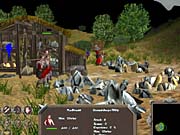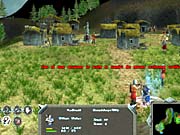You may remember Data Becker's previous game, America. It was a 2D real-time strategy game styled after the Age of Empires series, and it was, not surprisingly, set in America. Data Becker's newest game, Highland Warriors, takes place in a different era on a different continent. The game does a good job of portraying the units and landscapes that you'd expect to see in a game that takes place in medieval Scotland, but unfortunately, Highland Warriors' historical accuracy doesn't compensate for the deficiencies in its gameplay and graphics.

In Highland Warriors, you play as various factions that guided the history of the nation through several centuries. You unite the country's clans under a single king, play as the English in their conquest of Scotland, rebel against the English as William Wallace, and finally reunite the clans and claim independence with Robert the Bruce. Highland Warriors offers plenty of single-player gameplay to keep you occupied for some time. The game has four campaigns that consist of 10 missions each, and it has a skirmish mode against the computer AI. Highland Warriors also has a multiplayer mode that lets you take your highlanders online against a human opponent.
It's too bad, then, that the core gameplay doesn't quite hold up. Highland Warriors' gameplay resembles the same sort of formula you've probably seen in other real-time strategy games: gather resources, build a base, build an army, and attack. Peasants construct buildings and gather the game's five resources: wood, food, stone, iron ore, and gold. The game takes an interesting approach to resource gathering. Workers gain experience points as they gather a certain type of resource, and after a while, they can obtain a master-craftsman award that lets them gather that specific resource more quickly, at the expense of being more inefficient at gathering other kinds of resources. It's not a new concept, but it's rarely been implemented well in a real-time strategy game. Highland Warriors seems to take a step in the right direction in this regard, but the system ends up seeming like a gimmick. Workers achieve mastery very quickly, so creating specialized workers isn't really a challenge or much of an achievement.
Highland Warriors has variable weather--seasons change in the game every 20 minutes or so, and the change in weather affects the way you collect the food resource. You can't cultivate fields in winter, so you must have either enough stored food or alternative food sources. It's another interesting idea, but this, too, ends up being more of an annoying gimmick than anything else. While many strategy games have moved away from micromanagement of individual units and instead use intelligent peon units to help players gather resources and build bases, Highland Warriors' approach to resources sticks out like a sore thumb. You can have fields automatically replant themselves, but if you don't have enough wood (which happens frequently, since fields are quite expensive), the option becomes unchecked, and you'll have to manually reenable it. Otherwise, your peasants just sit idle in the barren field without finding something to do on their own. Then again, you often don't even need to bother with this complex system, since you can pick berries, hunt animals, and "build" cattle for a very cheap price in gold. Just sticking to cattle is usually sufficient for single-player games, because you'll rarely find yourself running out of gold before you finish a mission.
In fact, the game doesn't even begin to get challenging until you get fairly fair into the campaigns. Most real-time strategy fans should be able to breeze through the first campaign without having to restart a single mission. Certain missions will start you out with an initial force of troops, and in some cases, you can just take these soldiers and rush your enemy's base, finishing the mission in just a few minutes. At least the campaigns don't get too monotonous, because each side has different units. There are infantry, cavalry, ranged, and siege units in the game, and some of the game's playable factions even have magic-using units, such as druids, mages, and rangers. Unfortunately, Highland Warriors doesn't let you know how well a unit performs--when you select a unit, you will get no indication of its strengths or combat abilities. You can only make an educated guess based on the cost. You can upgrade each unit type, but similarly, the game doesn't tell you how much the unit will improve.
There isn't much to combat itself in Highland Warriors. There aren't too many tactical options beyond setting a few formations and behaviors, though the game does have one rather notable behavior: the blood frenzy. When you use this ability, your units will disperse and attack the nearest threat automatically. The downside is that you lose control of those units and can't give them direct orders, though you can reset their behavior to normal to regain control. It's an interesting option, but you'll generally use it only when you know you'll overwhelm your opponent.
Highland Warriors' AI on the whole is pretty average. The computer is intelligent enough to continually attack you with mixed forces and actually has pretty good pathfinding--units won't have problems getting to their destinations unless there's a big mountain blocking their way. However, sometimes your computer-controlled opponents make stupid tactical decisions. For instance, if your enemies are attacking your defense towers and you send a peasant to repair your towers, the enemy won't attack the peasant to stop the repairs. This is another flaw in the game: A single peasant can repair a building faster than five units can damage it. Irrationally, you'll find yourself constantly ordering your units to kill off the large numbers of peasants that your computer-controlled opponents will send to repair their structures.

Highland Warriors looks pretty good, at a glance. If you play the game from a zoomed-out view, you can see some good environmental effects like real-time shadows and trees swaying in the wind. When you zoom in, you'll also see that every unit has a good amount of detail. Unfortunately, every unit looks the same. In a game that features so much detail that individual objects begin to look like true individuals, it's disturbing to see dozens of identical-looking units running around. The problem is further compounded by the horrible unit animations. When they're killed, units go as stiff as a board and fall over, and in many cases, the game lacks animations for moving from location to location so that some units will freeze in place and seem to "skate" back and forth, as though they were on ice. In addition, if you were expecting to play Highland Warriors and find reenactments of the gory, dramatic battles of Mel Gibson's award-winning film Braveheart, you'll be disappointed to find that the game has no bloodshed at all. The game itself uses a rather bland and dreary color scheme, though at least it's fully 3D and has good camera controls. Highland Warriors also doesn't sound like much; its background music consists of Scottish tunes that are easily ignored. Many units in the game sound exhausted or extremely demoralized when they fight--rather than shouting out battle cries, they'll moan and groan as they head out to battle.
Highland Warriors has some good ideas, but it lacks polish, and it's difficult to recommend, especially considering some of the other amazing real-time strategy games we've seen in the past year or so. Even so, it does have some strong points, and at least it offers plenty of missions to keep you busy, so you could certainly do worse.